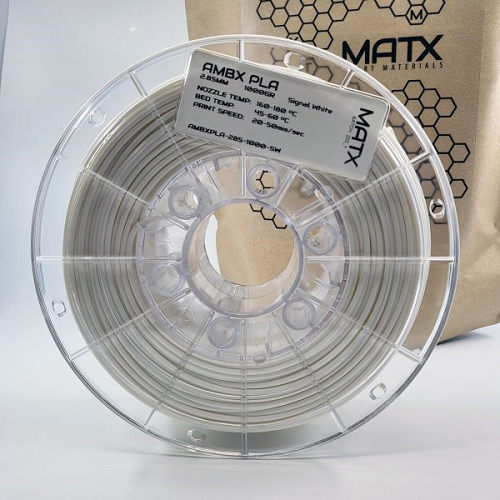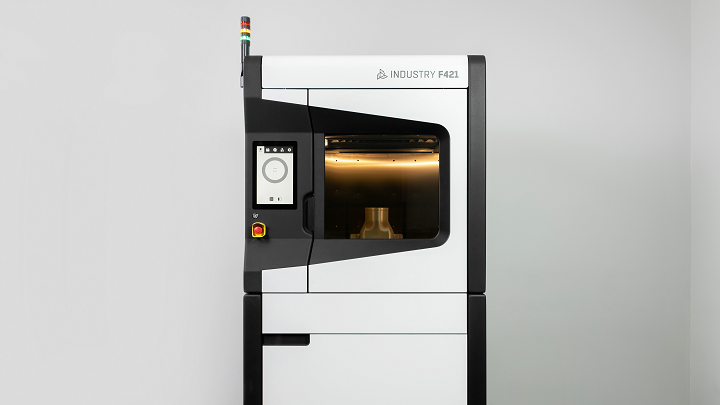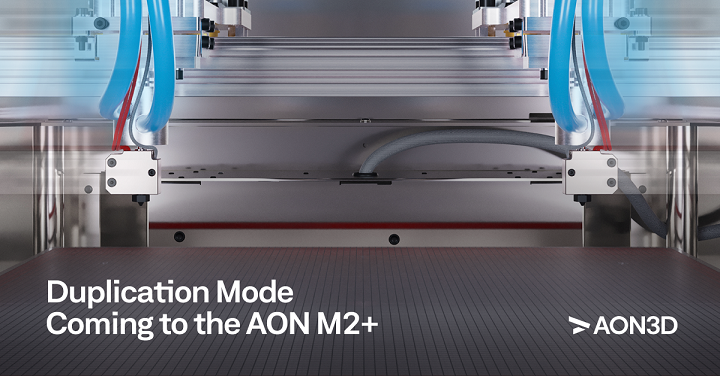We’re starting with new materials in today’s 3D Printing News Briefs, as MatX Smart Materials released an antimicrobial PLA and Evonik launched its osteoconductive VESTAKEEP for 3D printed implants. 3DGence introduced a new material and a new 3D printer, and AON3D announced a new M2+ firmware upgrade for Duplication Mode and Mirror Mode 3D printing. Thangs learned that it is the world’s largest 3D search engine. Finally, GE is planning a new engine with CFM and Airbus—what’s the likelihood it will use 3D printed parts?
MatX Developed Environmentally Friendly Antimicrobial Filament
First up, unique granulate and filament provider MatX Smart Materials developed AMBX PLA, a new environmentally friendly 3D printing filament that prevents bacterial growth. This antimicrobial material, made from natural ingredients, is said to be >99.99% effective against bacteria. This means bacteria that come in contact with this biocide-free filament will have an extremely low chance of survival, and that the material will continue to inhibit the growth of microbes. MatX Smart Materials says that objects 3D printed with its new AMBX PLA are resistant to bacteria, biofilm, molds, and viruses, including SARS-CoV-2, which causes COVID-19.
The new antimicrobial AMBX PLA filament doesn’t contain harmful or toxic substances like some of its competitors do, which makes it safe for human, animal, and environmental use—even in medical applications. The material has gone through extensive testing, and is available in white, in both 1.75 and 2.85 diameters. MatX Smart Materials is also working on more innovative materials, including one that uses Far Infrared (FIR) to generate an interaction between an object and human skin; this increases blood circulation and results in faster recovery and improved body performance.
Evonik Introduces VESTAKEEP Fusion PEEK for 3D Printed Implants
Specialty chemical company Evonik also launched a new material—osteoconductive PEEK filament VESTAKEEP® iC4800 3DF, which is said to improve the fusion between 3D printed implants and bones. Developed for use with common FFF technology, the high-performance biomaterial features great biostability and biocompatibility, and comes in a 1.75 mm diameter wound onto 250 or 500 g spools. Tests show that the material also has improved osteoconductive properties, thanks to the functional biphasic calcium phosphate (BCP) additive that allows bone cells to more quickly adhere to implants and speed up patient recovery. Evonik is presenting its new VESTAKEEP® iC4800 3DF at the AAOS annual meeting in Chicago this week.
“No other application field showcases more the classic advantages of 3D printing, such as individualization or design freedom, than medical technology. Since the product launch of the first PEEK filament a good three years ago, we have been expanding the possibilities of modern medical technology in the individual treatment of patients using additive manufacturing by constantly developing new innovative biomaterials,” said Marc Knebel, Head of Medical Systems at Evonik.
3DGence’s New 3D Printer, Material, MMS, Three-Year Warranty
In addition to a new 3D printer, Material Management System (MMS), and three-year warranty, industrial 3D printing company 3DGence has also launched the next version of its FFF 3D printer series. The new INDUSTRY F421 has enhanced mechanics and components, quick-change printing modules, high-temperature chamber, and 3DGence Cloud connectivity for quick shifts from prototyping to rapid production. 3DGence is also releasing an AS9100-certified PEEK Aero filament for aerospace, space, and defense applications, which offers high-strength, UL94 V-0 flammability resistance, chemical resistance, and anti-corrosion. The company is also releasing its Material Management System (MMS) for automating material storage, preparation, and post-processing, particularly for high-temperature thermoplastics. The MMS has pre-programmed configurations for industrial filaments, along with a continuous data feed to 3DGence Cloud. Finally, 3DGence has announced a new three-year warranty in select markets for its INDUSTRY F421 and INDUSTRY F350 3D printers. The warranty will be available in select European markets later this year, and expand to other markets in 2023.
“With the launch of our new F421, and recent F350, we wanted to make our commitment clear to our users about our quality and service with this new industry standard in warranty. As the market has progressed in requirements and complexity of applications, we designed our printers to meet these enhanced expectations in build quality, component integrity, and ease of use and maintenance,” said Sebastian Sczasny, Technology Portfolio Director MS Galleon and Group CEO, 3DGence. “This 3 Year Warranty provides peace of mind for the user and emphasizes our commitment to a high-quality experience with 3DGence technology.”
AON3D to Release Duplication, Mirror Modes for M2+
While it’s not a new 3D printer, AON3D did announce that its high-temperature M2+ industrial 3D printer will be receiving an optional firmware upgrade in order to enable a new feature: Duplication Mode and Mirror Mode 3D printing. This is not yet a publicly available feature in the high-temperature 3D printing market, which will give the company a leg up on their competition, as it will double the output of M2+ printers. Thanks to this upgrade, the AON M2+ will be able to print two of the same part, or two mirrored parts at the same time using an Independent Dual Extrusion (IDEX) system, making it an ideal system for the factory floor.
The IDEX system that AON3D uses to enable Mirror Mode offers more design freedom, like the ability to print large internal geometries, and is also capable of 3D printing high-performance materials such as PEEK, PEKK, and ULTEM. The new Duplication and Mirror Modes should be available to users through a firmware upgrade by this fall. Current AON M2+ customers on a success plan will receive the update at no cost.
Thangs is World’s Largest 3D Search Platform
Moving on, Thangs, which is the only 3D search platform that lets users search by text or by uploading a model, recently announced a major milestone: that it is the world’s largest 3D search platform. It’s not even two years old yet, and Thangs already features more than 10 million user-generated models, has millions of users, and about every 1.5 seconds, a new search is started, which has increased the search volume 10x more over the last year. Additionally, the platform is taking mechanical engineering one step closer to 3D design autocomplete, so engineers won’t have to share different versions of designs back and forth.
Pretend you’re designing a single piston head, but then seeing a 3D model of a cylinder it fits in right away, in addition to models of full engines that fit the cylinder and piston on which you’re currently working. Designers and engineers can then use Thangs Workspace, a 3D model collaboration tool, to collaborate on and refine the model, no matter what design software they’re currently using. Thangs is making 3D design and collaboration quick and simple for mechanical engineers that work to design real-world products.
Will GE’s Next Engine Feature 3D Printed Parts?
Finally, CFM International, the joint company between Safran Aircraft Engines and GE, has signed an agreement with Airbus to work together on a hydrogen demonstration program, set to take to the friendly skies within the next few years. The overall goal of the program is to ground and flight test a hydrogen-fueled direct combustion engine to get ready for use in a zero-emission aircraft by 2035. Due to its size, advanced turbo machinery, and fuel flow, the partners chose a GE Passport turbofan engine to run on hydrogen, and CFM will modify its fuel system, control system, and combustor. It will be mounted on the testbed’s rear fuselage so the emissions can be monitored separately from the other engines.
So, what is the likelihood that this new hydrogen combustion engine will feature 3D printed components? Considering that each of GE’s LEAP engines—a product of CFM—features 18 to 19 3D printed fuel nozzles, I’d say it’s pretty high. The company’s GE9X engine also uses several 3D printed parts, and so do its ATP, FATE, and Catalyst engines. Airbus is also a frequent user of 3D printing. Hydrogen engines are used more often to fly to space, but these companies clearly aren’t afraid of using the technology to help power their aircraft.
Subscribe to Our Email Newsletter
Stay up-to-date on all the latest news from the 3D printing industry and receive information and offers from third party vendors.
You May Also Like
World’s Largest Polymer 3D Printer Unveiled by UMaine: Houses, Tools, Boats to Come
The University of Maine has once again broken its own record by unveiling the largest polymer 3D printer in the world. Surpassing its 2019 achievement, the new Factory of the...
Changing the Landscape: 1Print Co-Founder Adam Friedman on His Unique Approach to 3D Printed Construction
Additive construction (AC) is much more versatile than it seems, at first: as natural as it is to focus on the exciting prospect of automated home construction, there’s far more...
Gorilla Sports GE’s First 3D Printed Titanium Cast
How do you help a gorilla with a broken arm? Sounds like the start of a bad joke a zookeeper might tell, but it’s an actual dilemma recently faced by...
3D Printing Webinar and Event Roundup: April 21, 2024
It’s another busy week of webinars and events, starting with Hannover Messe in Germany and continuing with Metalcasting Congress, Chinaplas, TechBlick’s Innovation Festival, and more. Stratasys continues its advanced training...



































